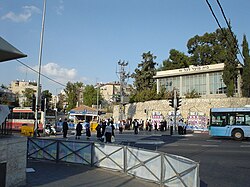Sanhedria
Appearance
31°47′54″N 35°13′15″E / 31.798379°N 35.220805°E

Sanhedria (
Maalot Dafna and the Sanhedria Cemetery
.
History

Sanhedria is named after the
rock-cut tombs constructed in the 1st century and thought to be the burial place of the members of the Sanhedrin.[1]
Until 1967, Sanhedria was a frontier neighborhood adjacent to the Jordanian border and dominated by privately owned Jewish agricultural plots. After the Six Day War, construction of new housing led to an influx of newcomers from the religious community who were attracted by the location, within walking distance of the Old City and Western Wall (2 km). Many institutions were built in the neighborhood.[2]

Until the 1980s, the neighborhood was composed of Haredi,
Further reading
- Sanhedriya – the northern border neighbouhood of Jerusalem: history, sites, people, and tour routes / Moshe Ehrnvald. Jerusalem: Yad Ben Zvi, 2016. (Hebrew)
References
- ISBN 1858282489.
- ^ a b Shlomit Flint, Itzhak Benenson and Nurit Alfasi: Between Friends and Strangers: Micro-Segregation in a Haredi Neighborhood in Jerusalem City & Community, June 2012.
Wikimedia Commons has media related to Sanhedria.
